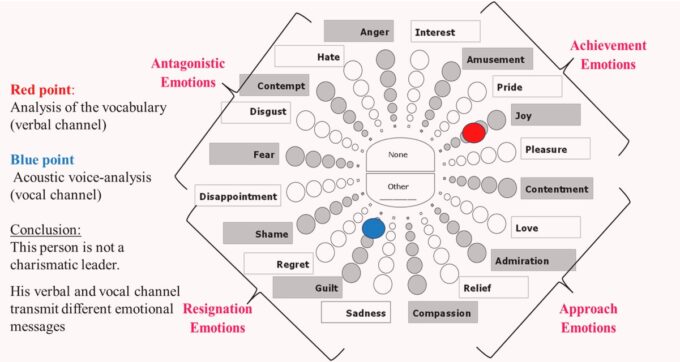
How to conduct your team to perform a masterpiece
Comedian and conductor Rainer Hersch says managers striving to lead high-performance teams can find inspiration in the concert hall. ...

by Branka Zei Pollermann Published February 1, 2024 in Leadership • 6 min read
Charisma is compelling attractiveness or charm that can inspire devotion in others. It is often perceived subconsciously when listeners pick up not just on what is said, but whether that message is delivered believably.
Some business executives stand out for their communication. Satya Nadella, Managing Director at Microsoft, is recognized for his clear style as well as his ability to connect with people on an emotional level, Indra Nooyi, the former chief executive of PepsiCo, can translate strategic ideas in a way that is easily understood, and his delivery of homespun wisdom makes Berkshire Hathaway chief executive Warren Buffett instantly credible to his listeners.
Why are leaders like this so effective? The reason is that every word in a language can be defined from three points of view – and the best communicators use all three to their advantage.
The first is its pleasantness, which we call “valence”. The second is “activation”, which means physiological arousal. The last point of view is “potency”, which is the ability and power to control a situation.
To give an example: if you were to talk about your last trip to Mount Everest, the level of pleasantness would be high – as would the level of physiological activation, if you were talking to a mountain climber. In addition, the potency would be high, particularly if you were talking to someone who had also climbed in the Himalayas.
If a speaker has the right values on these three basic competencies, they will already be perceived as a good speaker. But if, in addition to this, there is a congruence between what they say and how they say it, then they will be perceived as charismatic.
Charisma in speech can be scientifically assessed by the analysis of vocabulary and the acoustic analysis of the speaker’s voice.
Based on our research and analysis at the VOX Institute in Geneva over the past 35 years into speech communication, emotion, and social psychology, here are the five points that executives should bear in mind before they make a speech.


2. Think about pitch height
Appropriate pitch is crucial to making sure that people are convinced by what it is that you are saying and that your message is genuine. Take the example of a chief executive of a listed cosmetic firm. Despite reporting good quarterly results during an earnings call, the company was punished by the stock market and the share price dropped. On analyzing the chief executive’s voice, what became clear was that he didn’t sound convincing at all. This tone had been picked up subconsciously by analysts who were listening to the results.
Executives often think that if they speak more slowly it gives them power, but this only works if they have a low-pitched voice. If they have a high-pitched voice and do so, they just sound childish. Instead, they should consider how they use their voice and emphasize words and phrases more effectively to engage and persuade their audience.
To connect with your audience, it’s important to vary the pitch of your voice to prevent your speech being perceived as monotonous. This was the case for the director of a bank in Switzerland who was struggling with making presentations. Because there was very little difference between the high and low tones in her speech, her presentations fell flat.

“Executives should consider how they use their voice and emphasize words and phrases more effectively to engage and persuade their audience.”
At first, she thought this might be because she was speaking a foreign language (French). However, even when she was speaking her native tongue (English), things did not improve. The problem was that she had confused volume with pitch, and whenever she wanted to emphasize a word, she simply spoke more loudly. She should have varied the pitch instead.
At the VOX Institute, we worked out that the ideal pitch height for female speakers would be between 190 and 210 Hertz – something used consistently by the British television journalist Julie Etchingham. Another good example for executives to follow is British broadcaster and natural historian David Attenborough at the COP24 Sustainability Meeting in Katowice, Poland, in 2018.
Your speech rate – how many syllables you utter per second – makes a huge difference.
As an example, the prison service needed guidance because the guards were having difficulties convincing the prisoners to tidy their cells.
Following a series of workshops, they learned that a falling intonation and a slower rate of speech would help get the message across. In a follow-up session with the guards, they said that since implementing these changes, they had not had a problem with untidy cells.
As a rule of thumb, we have worked out that a speech rate of about 4.5 syllables per second is a good place to start.
Fluent speech (infrequent filled pauses/hesitations) is convincing to listeners. Here, eloquence is indissociable from oral delivery. Who does it well? Former US president Barack Obama and former British prime minister Tony Blair remain the world champions in that regard.
Within the world of business, Elon Musk – best known as the owner of automotive group Tesla and X, formerly known as Twitter – is often highly regarded, though this comes with some caveats. From the point of view of clarity – the difference between what he says and how he says it – he is generally fine. However, as there can be a considerable amount of hesitation in his speech, from the listener’s point of view, he may come across as not very fluent.
If executives are concerned about their fluency, synchronization of hand gestures with the rhythm of the spoken word can help.
Chunking makes a significant difference to whether you are understood by listeners. It is a technique related to short-term memory where you group words into smaller, more manageable units and put a little pause or intonation break in your speech.
If you don’t chunk, listeners struggle to understand what you are saying. In fact, the human working memory span is limited to “the magical number” 7 ± 2 units of information.
Prime ministers and public figures often write their speeches in the form of a poem with line breaks to make themselves pause. It is worth doing the same when you speak to make sure that listeners follow what you are saying.

Founder and Director of Vox Institute. researcher, trainer and lecturer at IMD
Branka Zei Pollermann is the founder and director of the Vox Institute. Founded in 1988, the Geneva-based training and research institute specializes in speech communication and vocal and nonverbal skills as well as the psychosocial and emotional determinants of behavior.

June 27, 2025 • by Rainer Hersch in Communication
Comedian and conductor Rainer Hersch says managers striving to lead high-performance teams can find inspiration in the concert hall. ...

April 22, 2025 • by D W Pine in Communication
Responsible for TIME magazine’s iconic covers, D W Pine explores his creative process and shares insights on how to cut through the noise and make an impact....

October 15, 2024 • by Robin de Haas in Communication
Pioneering vocal leadership coach Robin de Haas analyzes the breathing and speech patterns of US presidential candidates Kamala Harris and Donald Trump as evident in their recent debate and offers some sound...

August 2, 2024 • by Maude Pittet Nazareno, Francesca Giulia Mereu in Communication
Negotiation can be fraught even outside conflict zones. Lessons from frontline humanitarian negotiators show how awareness of the brain’s behavior centers can set you up for success....
Explore first person business intelligence from top minds curated for a global executive audience